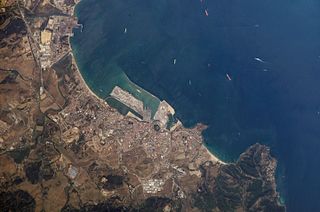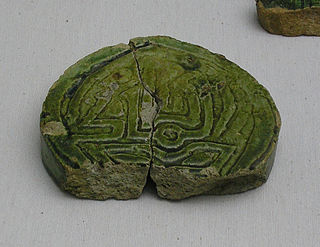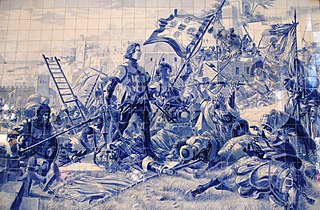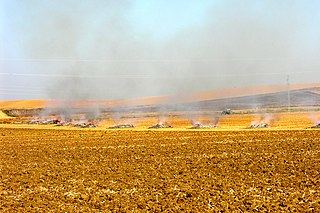 W
WThe Siege of Algeciras (1342–44) was undertaken during the Reconquest of Spain by the Castillian forces of Alfonso XI assisted by the fleets of the Kingdom of Aragon and the Republic of Genoa. The objective was to capture the Muslim city of Al-Jazeera Al-Khadra, called Algeciras by Christians. The city was the capital and the main port of the European territory of the Marinid Empire.
 W
WThe Battle of Algeciras was a naval battle which occurred on July 25, 1278. The battle pitted the fleets of the Kingdom of Castile, commanded by the Admiral of Castile, Pedro Martínez de Fe, and the combined fleets of the Marinid dynasty and that of the Emirate of Granada, commanded by Abu Yaqub Yusuf an-Nasr. The battle was fought in the context of the Moorish naval expeditions to the Iberian Peninsula. The battle, which took place in the Strait of Gibraltar, resulted in a Muslim victory.
 W
WThe Siege of Algeciras was the first of many sieges of the city by Christian forces in the lengthy period of the Spanish Reconquista. The siege, ordered by King Alfonso X of Castile also known as "el Sabio", was a fruitless military campaign initiated by the Kingdom of Castile with the objective of removing the Benimerins from Algeciras. The siege on Algeciras, then known to the Muslims as Al-Jazira Al-Khadra, was strategically important because Algeciras had been at the time the main fortress and landing place for African reinforcement troops in the Iberian Peninsula. Castile, which had a powerful armada of ships anchored in the Bay of Gibraltar to blockade such reinforcement, had a few days previously to the siege, seen that fleet obliterated by the Muslim admiral, Abu Yusuf Yaqub at the Naval Battle of Algeciras.
 W
WThe conquest of Ceuta by the Portuguese on 21 August 1415 marks an important step in the beginning of the Portuguese Empire in Africa.
 W
WThe Battle of Écija was a battle of the Spanish Reconquista that took place in September 1275. The battle pitted the Muslim troops of the Nasrid Emirate of Granada and its Moroccan allies against those of the Kingdom of Castile and resulted in a victory for the Emirate of Granada.
 W
WThe Battle of Estepona was a naval battle that occurred in the year 1342 between the armada of the Crown of Aragon, commanded by Admiral Pere de Montcada, against the fleet of the Marinid Dynasty. The battle took place in the Bay of Estepona in the Strait of Gibraltar and resulted in an Aragonese victory and a rout of the Marinid fleet.
 W
WThe Fourth Siege of Gibraltar, fought from June until August 1333, pitted a Christian army under King Alfonso XI of Castile against a large Moorish army led by Muhammed IV of Granada and Abd al-Malik Abd al-Wahid of Fes. It followed on immediately from the Third Siege of Gibraltar, fought earlier in 1333. The siege began inauspiciously with a disastrous landing by Castilian forces on the west side of Gibraltar, before developing into a stalemate in which neither side had the strength to capture Gibraltar, nor to break out or lift the siege. Both sides faced acute shortages of food – the Gibraltar garrison was cut off from resupply, while the Castilians, deep within enemy territory, could only be resupplied via an unreliable sea route. After two months of inconclusive siege warfare, the Castilians and Moors reached a truce agreement that allowed both sides to make an honourable exit from the siege. Although the Moors managed to keep Gibraltar, the truce cost Muhammed IV his life when he was assassinated by disgruntled nobles the day after signing it.
 W
WThe Fifth Siege of Gibraltar, mounted between August 1349 and March 1350, was a second attempt by King Alfonso XI of Castile to retake the fortified town of Gibraltar. It had been held by the Moors since 1333. The siege followed years of intermittent conflict between the Christian kingdoms of Spain and the Moorish Emirate of Granada, which was supported by the Marinid sultanate of Morocco. A series of Moorish defeats and reverses had left Gibraltar as a Moorish-held enclave within Castilian territory. Its geographical isolation was compensated for by the strength of its fortifications, which had been greatly improved since 1333. Alfonso brought an army of around 20,000 men, along with his mistress and their five illegitimate children, to dig in to the north of Gibraltar for a lengthy siege. In the New Year of 1350, however, bubonic plague – the Black Death – broke out in the Castilian camp. Alfonso refused to abandon the siege but fell victim to the plague on 27 March 1350, becoming the only monarch to die of the disease.
 W
WThe Siege of Jaén was one of many sieges on the city during the long Spanish Reconquista. The siege, which was carried out by the combined allied forces of the Kingdom of Castile and the Taifa of Baeza, commanded by Ferdinand III of Castile and Abd Allah Ibn Muhammad Al-Bayyasi of Baeza against the defending Taifa of Jayyān (جيان) whose forces were commanded by the notable Christian knight, Álvaro Pérez de Castro. The battle resulted in a Jayyānese victory as the Castilian forces did not capture the city. Areas around the city were totally devastated as a result of the siege. The siege occurred as a part of Ferdinand III's first campaign which occurred roughly from 1224 to 1230 and was undertaken before the Siege of Andújar that same year.
 W
WThe Siege of Jaén was one of many sieges on that city during the Spanish Reconquista. The siege was carried out from 24 June through September, 1230 by forces of the Kingdom of Castile commanded by Ferdinand III of Castile against the defending Taifa of Jayyān (جيان). The battle resulted in a Jayyānese victory after the Castilian withdrawal and abandonment of the siege immediately following the death of King Alfonso IX of León.
 W
WThe Siege of Jaén was the final siege on the city during the Spanish Reconquista. The siege, was carried out from 1245 through 28 February 1246 by forces of the Kingdom of Castile and the Order of Santiago commanded by Ferdinand III of Castile and the Grand Master of the Order of Santiago, Pelayo Pérez Correa, against a combined defending force of the local Taifa of Jaén (جيان) and the Emirate of Granada under Muhammad I. The battle resulted in a Castilian victory with the city of Jaén being handed over to the Kingdom of Castile and Leon after the signing of the Treaty of Jaén.
 W
WThe Battle of Río Salado, also known as the Battle of Tarifa was a battle of the armies of King Afonso IV of Portugal and King Alfonso XI of Castile against those of Sultan Abu al-Hasan 'Ali of the Marinid dynasty and Yusuf I of Granada.
 W
WThe Battle of Vega de Pagana was a battle between forces loyal to the King Alfonso XI of Castile against those mainly of the Maranid sultan Abu al-Hasan 'Ali of Morocco.